ELIMINATING THE HUMAN
by David Byrne | May 15, 2017
I have a theory that much recent tech development and innovation over the last decade or so has had an unspoken overarching agenda—it has been about facilitating the need for LESS human interaction. It’s not a bug—it’s a feature. We might think Amazon was about selling us books we couldn’t find locally—and it was and what a brilliant idea—but maybe it was also just as much about eliminating human interaction. I see a pattern emerging in the innovative technology that has gotten the most attention, gets the bucks and often, no surprise, ends up getting developed and implemented. What much of this technology seems to have in common is that it removes the need to deal with humans directly. The tech doesn’t claim or acknowledge this as its primary goal, but it seems to often be the consequence. I’m sort of thinking maybe it is the primary goal. There are so many ways imagination can be manifested in the technical sphere. Many are wonderful and seem like social goods, but allow me a little conspiracy mongering here—an awful lot of them have the consequence of lessening human interaction.
I suspect that we almost don’t notice this pattern because it’s hard to imagine what an alternative focus of tech development might be. Most of the news we get barraged with is about algorithms, AI, robots and self driving cars, all of which fit this pattern, though there are indeed many technological innovations underway that have nothing to do with eliminating human interaction from our lives. CRISPR-cas9 in genetics, new films that can efficiently and cheaply cool houses and quantum computing to name a few, but what we read about most and what touches us daily is the trajectory towards less human involvement. Note: I don’t consider chat rooms and product reviews as “human interaction”; they’re mediated and filtered by a screen.
I am not saying these developments are not efficient and convenient; this is not a judgement regarding the services and technology. I am simply noticing a pattern and wondering if that pattern means there are other possible roads we could be going down, and that the way we’re going is not in fact inevitable, but is (possibly unconsciously) chosen.
Here are some examples of tech that allows for less human interaction:
Online ordering and home delivery- Online ordering is hugely convenient. Amazon, FreshDirect, Instacart, etc. have not just cut out interactions at bookstores and checkout lines, they have eliminated ALL human interaction barring the (often paid) online recommendations. New York has had home take-out delivery for decades—one simply phones the local take-out place—but New York also has never had a shortage of random human interaction.
Here’s an Amazon warehouse in Peterborough, Cambridge. Increasingly the picking is done by a combination of humans working with robots. I can see eight people in this picture.
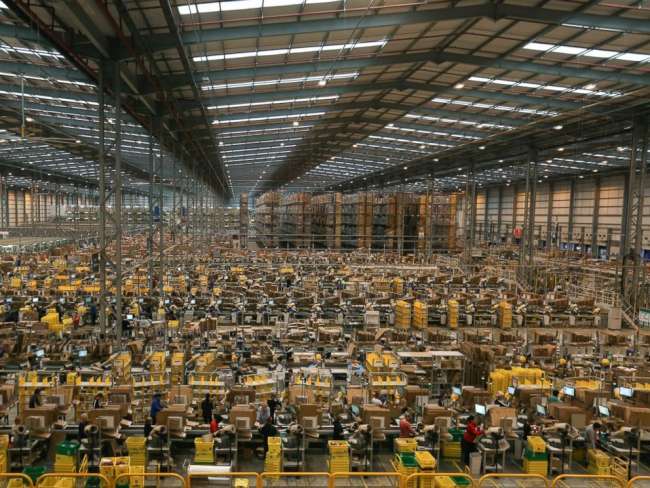
Gig Jobs- TaskRabbit and other services—there are people who perform these tasks in the gig economy, but as a client one does not necessarily have to interact with them in a meaningful way.
Airbnb- There is no check-in desk interaction; often there is no human contact at all.
Digital music- Downloads and streaming—there is no physical store, of course, so there are no snobby, know-it-all clerks to deal with. Whew, you might say. There are algorithmic recommendations on some services so you don’t even have to discuss music with your friends to know what they like—the service knows what they like, and you can know too without actually talking to them. Is music as a kind of social glue and lubricant also being eliminated?
Car driver apps- There is minimal interaction—one doesn’t have to tell the driver the address, the preferred route or interact while paying the check.
Driverless cars- In one sense, if you’re out with your friends, not having one of you drive means more time to chat. Or drink. Very nice. But driverless tech is also very much aimed at eliminating taxi drivers, truck drivers, delivery drivers and many others. There are huge advantages to eliminating humans here—theoretically machines should drive more safely than humans—so there might be fewer accidents and fatalities. The disadvantages include massive job loss. But that’s another subject. What I’m seeing here is the consistent “eliminating the human” pattern.
Automated checkout- Eatsa is a new version of the Automat, a once popular “restaurant” with no visible staff. My local CVS has been training their staff to help us learn to use the checkout machines which will replace them. At the same time, they are training their customers to do the work of the cashiers.

Amazon has been testing stores—even grocery stores!—with automated shopping. They’re called Amazon Go. If the items are placed perfectly on the shelves, then sensors know what you’ve picked up, and you can simply walk out with your “purchases” without any human contact. But they still need to get quite a few bugs out.
At some airports, one orders and pays via tablets—that system has some bugs in it too. I watched a lot of people simply walk away in frustration, but those bugs will get sorted someday soon.
Online Art Sales- Art is increasingly being sold online, so one can avoid any possible awkward encounters with intimidating gallery staff.
eBay- “Auctions” without the human drama and excitement.
AI- AI is often (though not always) truly better at decision-making than humans. In some areas, we might expect this. For example, AI will suggest the fastest route on a map accounting for traffic and distance while we as humans wouldn’t have the time to check all that traffic data, and we’d be prone to taking our tried and true route. But some less expected areas where AI is better than humans are opening up. As Siddhartha Mukherjee writes in The New Yorker, AI is getting better at spotting melanomas than many doctors. Much routine legal work will soon be done by computer programs and financial assessments are now being done by machines.
Robot workforce- A little distinct from AI, robots are physical machines. Factories increasingly have fewer and fewer workers, which means no personalities to deal with, no workers agitating for overtime, and no illnesses. Using robots avoids an employer’s need to think about worker's comp/liability, healthcare, social security and medicare taxes and unemployment benefits.
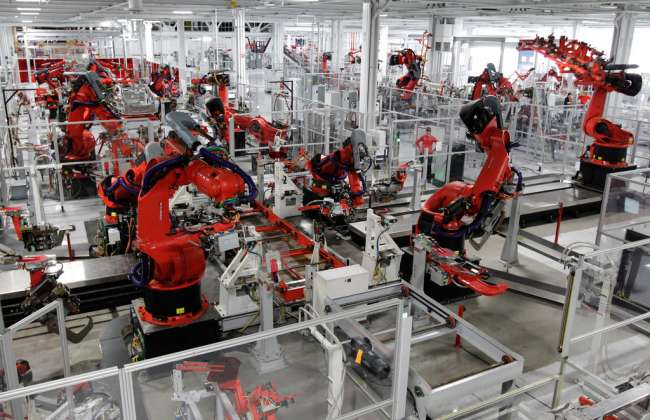
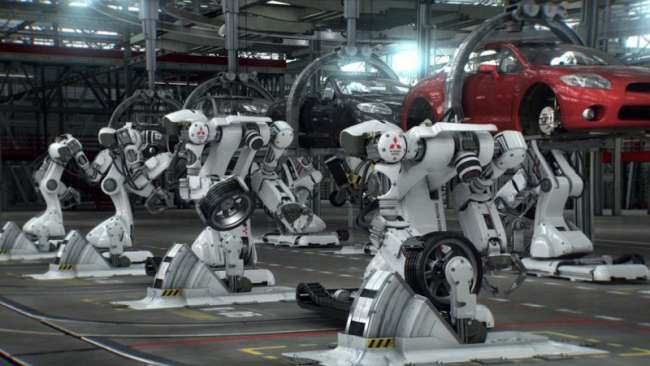
Personal assistants- Google Home and Amazon Echo—with improved speech recognition, one can increasingly talk to a machine rather than a person. (There is the attendant question of whether these machines are always listening and possibly recording or at least tabulating one’s speech. Even when not officially addressed, an “offline” discussion might be used to improve a recommendation, for example). Amusing stories abound as the bugs get worked out. The child who says “Alexa, I want a dollhouse”... and lo and behold the parents find one in their cart. When this story became an online viral news item, the news segment replayed the girl’s request, and soon a lot of people with Amazon Echos had dollhouses in their carts.
Data analysis of behavior- Improvements and innovations in crunching massive amounts of data mean that patterns can be recognized where they weren’t seen previously. “Trust the data, not your lying eyes.” We will come to trust the gleanings from data crunching more than we do ourselves and our human colleagues and friends.
Video games (and VR)- Yes, some online games are interactive—but most are played in a room by one person jacked into the game—the interaction is virtual.
Automated high-speed stock buying and selling- A machine crunching huge amounts of data can spot trends and patterns quickly and act on them faster than a person can.
MOOCS- Online education, with no direct teacher interaction.
Lastly, "Social" media- social “interaction” that isn’t really social.
While the appearance on social networks is one of connection—as Facebook and others frequently claim—the fact is a lot of social media is a simulation of real social connection. As has been in evidence recently, social media actually increases divisions amongst us by amplifying echo effects and allowing us to live in cognitive bubbles. We are fed what we already like or what our similarly inclined friends like… or more likely now what someone has payed for us to see in an ad that mimics content. In this way, we actually become less connected except to those in our group.
Social networks also increase envy and unhappiness. From a recent study:
“The challenge is that most of the work on social interaction has been conducted using ‘real world,’ face-to-face social networks, in contrast to the types of online relationships that are increasingly common.
Overall, our results showed that, while real-world social networks were positively associated with overall well-being, the use of Facebook was negatively associated with overall well-being. These results were particularly strong for mental health; most measures of Facebook use in one year predicted a decrease in mental health in a later year. We found consistently that both liking others’ content and clicking links significantly predicted a subsequent reduction in self-reported physical health, mental health, and life satisfaction.”
While claiming to connect us, the sad and surely unintended effect is that they also drive us apart. This, in my opinion, is partly due to pandering to the pleasure one gets from only hearing things you agree with, but it’s also because the social connection was never real, it was virtual—not between real people but between their online selves.
The counterargument to the dangers of social media has been “look at Arab Spring”. Yes, social media was a much used tool to spread news and to alert, but can social media be credited with facilitating the uprising? The answer is complicated, and there are various points of view.
It seems that an equally important factor in the rise and manifestation was how well-organized the groups were. And we can’t forget that it’s a two way street—social media was also used by the oppressive regimes to tack down and locate the resistance.
Malcolm Gladwell writes in The New Yorker:
“‘High risk’ social activism requires deep roots and strong ties. But surely the least interesting fact about them is that some of the protesters may (or may not) have at one point or another employed some of the tools of the new media to communicate with one another. Please. People protested and brought down governments before Facebook was invented. They did it before the Internet came along. Barely anyone in East Germany in the nineteen-eighties had a phone—and they ended up with hundreds of thousands of people in central Leipzig and brought down a regime that we all thought would last another hundred years—and in the French Revolution the crowd in the streets spoke to one another with that strange, today largely unknown instrument known as the human voice. People with a grievance will always find ways to communicate with each other. How they choose to do it is less interesting, in the end, than why they were driven to do it in the first place.”
Many transformative movements in the past succeed based on leaders, agreed upon principles and organization. Although social media is a great tool for rallying people and bypassing government channels, it does not guarantee eventual success.
Social media is not really social—ticking boxes and having followers and getting feeds is NOT being social—it's a screen simulation of human interaction. Human interaction is much more nuanced and complicated than what happens online. Engineers like things that are quantifiable. Smells, gestures, expression, tone of voice, etc. etc.—in short, all the various ways we communicate are VERY hard to quantify, and those are often how we tell if someone likes us or not.
Why this focus on bypassing humans?
There are lots of reasons one might want to avoid human interaction:
1. Human interaction is perceived as complicated, inefficient, noisy and slow.
2. Less human interaction makes for cheaper manufacturing, services and exchange. It’s good, at least in the short run, for the bosses, owners and investors.
3. We’re told that automation means we won’t have to work at menial tasks any more. We’ll have more leisure time—though how we’ll make a living is a looming question.
4. Engineers and coders as people are often less than comfortable with human interaction, so naturally they are making a world that is more accommodating to themselves.
This last one might be a bit contentious, but hear me out. My theory is that much tech was coded and created by folks somewhere on the spectrum (I should know—I’m different now, but I used to find most social interactions terrifying). Therefore, for those of us who used to or who do find human interactions awkward and uncomfortable, there would naturally be an unconscious drive to make our own lives more comfortable—why wouldn’t we? One way for an engineer to do that would be to remove as much human interaction from their life, and therefore also our lives, as possible. Part of something being “frictionless” is getting the human part out of the way.
Humans are capricious, erratic, emotional, irrational and biased in what sometimes seem like counterproductive ways. Some claim that the survival of humans depends on us giving some control over to the machines—we seem to be botching the CO2 emission control issue pretty badly, for example. It often seems that our emotional, quick-thinking and selfish nature will be our downfall. There are lots of arguments for getting humans out of the equation, but many might not admit that it is a conscious goal. The stated goal might be finding melanomas or ordering groceries, not eliminating human interaction.
I’m also not saying that any of these apps and tech are not hugely convenient, clever or efficient. I use many of them. But from the automated checkout lines to self-driving cars, I see a trend that is accelerating, and I sense that as it does, human interaction will become rarer and therefore increasingly more difficult for people—not just people on the spectrum, but for all of us.
Is there a downside?
Obviously jobs are a big question mark. When people become superfluous, what do they do for a living? Two MIT faculty members claim that productivity has become “decoupled” from wages and employment. We’re becoming more efficient but don’t need as many people.
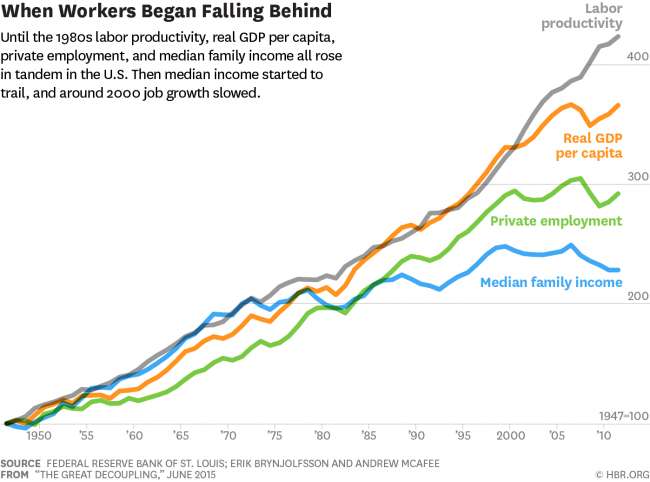
This is another whole topic—too big to tackle here. There are arguments on both sides—some claim that jobs will arise for the technically unemployed, others say that they won’t. Here are the various professions and how they’re progressing toward being digitized (which translates to “jobs being done without humans”):
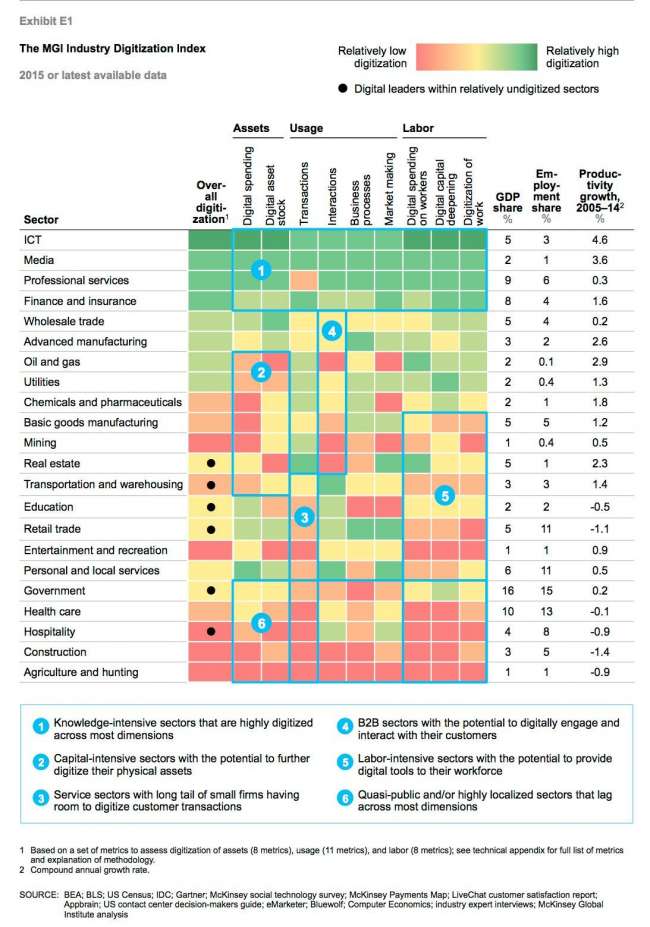
My dad was an electrical engineer—I love the engineer's’ way of looking at the world. I myself applied to both art school AND to engineering school (my frustration was that there was little or no cross-pollination. I was told at the time that taking classes in both disciplines would be VERY difficult). I am familiar with and enjoy both the engineer's mindset and the arty mindset (and I’ve heard that now mixing one’s studies is not as hard as it used to be).
The point is not that making a world to accommodate oneself is bad, but that when one has as much power over the rest of the world as the tech sector does, over folks who don’t naturally share its worldview, then there is a risk of a strange imbalance. The tech world is predominantly male—very much so. Testosterone combined with a drive to eliminate as much interaction with real humans as possible—do the math, and there’s the future.
We’ve gotten used to service personnel and staff who have no interest or participation in the businesses where they work. They have no incentive to make the products or the services better. This is a long legacy of the assembly line, standardising, franchising and other practices that increase efficiency and lower costs. It’s a small step then from a worker that doesn’t care to a robot. To consumers, it doesn’t seem like a big loss.
Those who oversee the AI and robots will, not coincidentally, make a lot of money as this trend towards less human interaction continues and accelerates—as many of the products produced above are hugely and addictively convenient. Google, Facebook and other companies are powerful and yes, innovative, but the innovation curiously seems to have had an invisible trajectory. Our imaginations are constrained by who and what we are. We are biased in our drives, which in some ways is good, but maybe some diversity in what influences the world might be reasonable and may be beneficial to all.
To repeat what I wrote above—humans are capricious, erratic, emotional, irrational and biased in what sometimes seem like counterproductive ways. I’d argue that though those might seem like liabilities, many of those attributes actually work in our favor. Many of our emotional responses have evolved over millennia, and they are based on the probability that our responses, often prodded by an emotion, will more likely than not offer the best way to deal with a situation.
Neuroscientist Antonio Damasio wrote about a patient he called Elliot, who had damage to his frontal lobe that made him unemotional. In all other respects he was fine—intelligent, healthy—but emotionally he was Spock. Elliot couldn’t make decisions. He’d waffle endlessly over details. Damasio concluded that though we think decision-making is rational and machinelike, it’s our emotions that enable us to actually decide.
With humans being somewhat unpredictable (well, until an algorithm completely removes that illusion), we get the benefit of surprises, happy accidents and unexpected connections and intuitions. Interaction, cooperation and collaboration with others multiplies those opportunities.
We’re a social species—we benefit from passing discoveries on, and we benefit from our tendency to cooperate to achieve what we cannot alone. In his book, Sapiens, Yuval Harari claims this is what allowed us to be so successful. He also claims that this cooperation was often facilitated by a possibility to believe in “fictions” such as nations, money, religions and legal institutions. Machines don’t believe in fictions, or not yet anyway. That’s not to say they won’t surpass us, but if machines are designed to be mainly self-interested, they may hit a roadblock. If less human interaction enables us to forget how to cooperate, then we lose our advantage.
Our random accidents and odd behaviors are fun—they make life enjoyable. I’m wondering what we’re left with when there are fewer and fewer human interactions. Remove humans from the equation and we are less complete as people or as a society. “We” do not exist as isolated individuals—we as individuals are inhabitants of networks, we are relationships. That is how we prosper and thrive.





